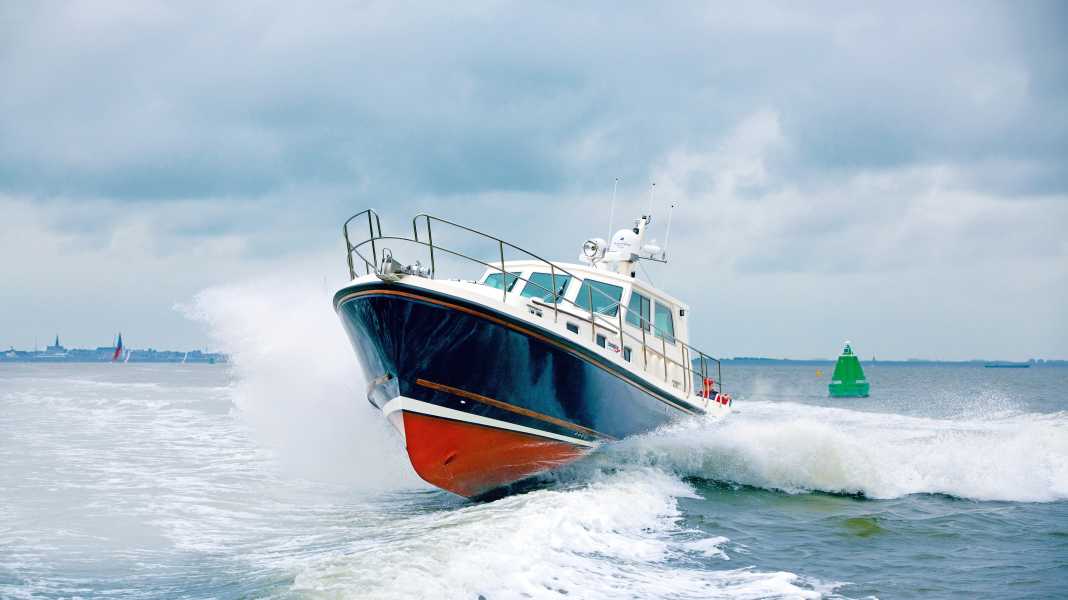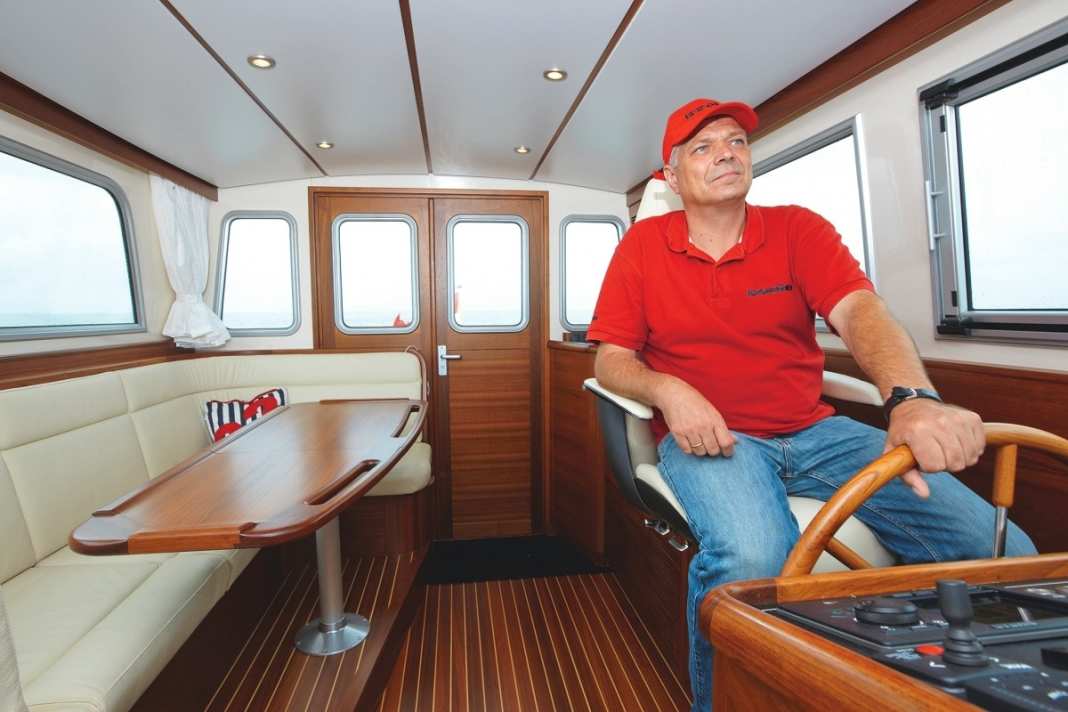






What's good for pilots can't be bad for leisure skippers. This must have been the motto of the responsible designers at North-Line when they put their series on paper. Because not only our test boatNorth-Line Express 42 shows the typical crack of a pilot boat, but the four sisters 34, 37, 48 and 60 feet as well.
The boats are built from polyester resin and fibreglass mats. A look at the neatly finished plastic and wood shows that the boat builders at North-Line build solidly.
However, there were also weaknessessuch as the already cracked saloon door, wobbly passenger seat and leaking side window. All details that the shipyard has also recognised and wants to rework. In the engine compartment, we don't like an oil drain line (port engine) that is rubbing against the foundation and already has visible damage. Cooling water hose holders made of sharp-edged perforated tape - only padded with a little foam - are also not a permanent solution.
It is better to lay the cables in the cable ducts and the hydraulic pipes (control unit) in clamps. The following contribute to operational safetyFuel filter with water separator, sight glass and electrical alarm as well as the separate 24 V starter and on-board power circuits (400 Ah) and the main switch relays plus manual switches for emergency operation. The consumers are switched and monitored at a control centre at the rear of the driver's cab and on a touchscreen display on the instrument panel.
The driver operates the engine and rudder via an electronic double single-lever control (unusually positioned on the left) and a wooden steering wheel.
The latter can be used without restriction when seated, but when travelling standing up, the space is only sufficient despite the seat being pushed all the way back. Most of the time, however, you drive sitting down, becausethe pilot-like driver's seat offers every comfort. The front passenger sits on a softly upholstered estate seat, which either faces forwards or can be converted into a saloon seat with an electrically folding backrest.
All-round visibility is guaranteed by thick safety glass panes in all the fronts and doors. You can tell straight away that we are travelling in aCE category A boat because the windscreens all sit in thick struts that give the wheelhouse stability. Three double-arm windscreen wipers ensure a clear view on rainy days and when splashing water is present. Due to the dark colour of the wheelhouse, reflections in the windows are kept to a minimum and there are also no unusual reflections on the instruments.
To optimise theForesight during the journey the driver has to push the nose down with the trim tabs, because the faster you go, the more the bow rises and blocks the view. The shipyard recommends a cruising speed of 2500 rpm, which according to our measurements gives a speed of around 18 knots. With a fuel consumption of a good 4.5 l/sm, this results in a range of around 400 nm plus 15% reserve, which is suitable for a boat of this class.
Full-throttle pilots have to stop at the petrol station after just over 250 nm, while those who take it easy and only travel at 7 kn can cover more than 1500 nm.
The round tensioner runs in displacement mode -front with deep V - The boat continues straight ahead and gently enters the stern of ferries on the North Sea. At high speed, it does the same and only a little spray comes over. The course has to be corrected from time to time, which is easiest to do from theAutopilots (extra) can be done.
During the quick turnaround, however, it should be switched off in order toroundabouts as narrow as possible (about 5 boat lengths). The hull first lies on the inside of the bend, then swings back and lies slightly on the outside. When steering into the roundabout, you can feel a lot of pressure on the steering wheel, otherwise it is easy to turn. During slow harbour manoeuvres, the skipper only needs the rudder a little, as the 42 Expresswith twin engine system and bow thruster (extra) easy to conduct.
Exemplary: in the engine compartment you will findan emergency control devicein case the normal hydraulic steering fails. The safety equipment also includes: manual bilge pump, four electric bilge pumps, fire extinguishing system in the engine compartment and extinguisher in the galley.
The designer integrated the latter amidships at the level of the dinette, which offers space for four people. Both are lower than the saloon in the wheelhouse, guaranteeing greater discretion.
Further towards the bow is the well-ventilated wet room (accessible from the owner's cabin and dinette) with electric toilet and shower (behind a semi-circular sliding door). Directly in the bowthe owner's cabin with ample storage space, but not ventilated cushions. The same applies to the single and double berths in the guest cabin (with its own bathroom). You have to be careful with your head in this room, as there are some bumpy edges on the ceiling.
Conclusion
The North-Line has classic lines and offers good safety equipment. Apart from a few weak points, the workmanship of the North-Line makes a rock-solid impression. With its two Cummins diesel engines, our test boat has appealing handling characteristics. Four people travel comfortably on the 48 Express and can also take on rougher routes.
Data sheet: North-Line 42 Express Wheelhouse
Shipyard: North-Line Yachts
Type designation: North-Line 42 Express Wheelhouse
CE category: A - High seas
Material of hull and deck: Plastic
Length: 13,80 m
Width: 4,10 m
Displacement: 13,00 t
Price: 605.000,00 €
Downloads:
download

